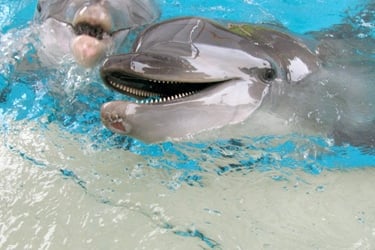Just 13 months after a PETA complaint prompted the U.S. Department of Agriculture (USDA) to cite SeaWorld’s Orlando park for violations of the Animal Welfare Act—including allowing dolphin and orca tanks to fall into dangerous disrepair—the park has racked up more, repeat violations for many of the same issues.
Newly obtained public records reveal that on January 13, 2014, SeaWorld was cited for failing to maintain the flooring at Sea Lion and Otter Stadium—the rubber flooring on which the animals walk during shows was dangerously dislodged and littered with paint chips. The park had been issued a citation in 2007 for the same problem in the same location, and in 2013, it had been cited for failing to keep a dolphin tank and an area surrounding an orca performance tank in a safe condition. During the January 2014 inspection, SeaWorld was also cited for continuing to keep dozens of expired surgical sutures—which can become unsterile, result in premature suture failure, and lead to life-threatening infections in the animals—in its surgery room despite a previous USDA directive to develop a protocol for disposing of expired sutures.
“The tiny tanks at SeaWorld are inherently cruel, and when the tanks and surrounding areas are also rusting, peeling, and flaking, they’re downright dangerous for the animals confined there,” says PETA Foundation Deputy General Counsel Delcianna Winders. “With crumbling facilities and expired veterinary supplies, it’s clear that SeaWorld’s first priority is profit, not animal safety.”
The 2013 disrepair-related violations at SeaWorld include allowing a dolphin tank’s concrete to become cracked and crumbling, with rusty beams overhead, and allowing the flooring surrounding the orca performance tank to become loose, worn, and chipped away. The USDA warned that the unsafe conditions “might create a health risk if these pieces of concrete fall off into the pool and get ingested, or if they become abrasive.”





